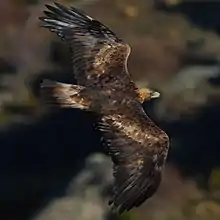鵰
| ||||||||
Translingual
Han character
鵰 (Kangxi radical 196, 鳥+8, 19 strokes, cangjie input 月口竹日火 (BRHAF), four-corner 77227, composition ⿰周鳥)
References
- KangXi: page 1492, character 11
- Dai Kanwa Jiten: character 47012
- Dae Jaweon: page 2022, character 20
- Hanyu Da Zidian (first edition): volume 7, page 4642, character 1
- Unihan data for U+9D70
Chinese
| trad. | 鵰/雕* | |
|---|---|---|
| simp. | 雕* | |
| 2nd round simp. | ⿰刁鸟 | |
| nonstandard simp. | 𫛲 | |

鵰/雕
Etymology
From Proto-Sino-Tibetan *daw (“bird”); cognate with 鳥 (OC *tɯːwʔ) (STEDT).
Pronunciation
Descendants
Japanese
Readings
- Go-on: ちょう (chō)←てう (teu, historical)
- Kan-on: ちょう (chō)←てう (teu, historical)
- Kun: わし (washi, 鵰); きざむ (kizamu, 鵰む); ほる (horu, 鵰る)
This article is issued from Wiktionary. The text is licensed under Creative Commons - Attribution - Sharealike. Additional terms may apply for the media files.